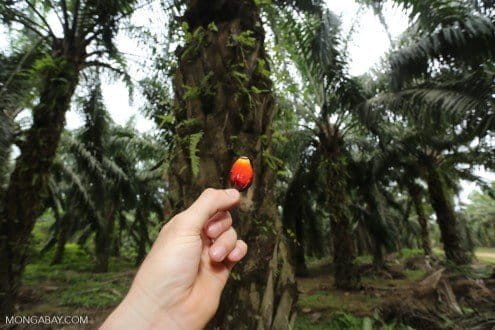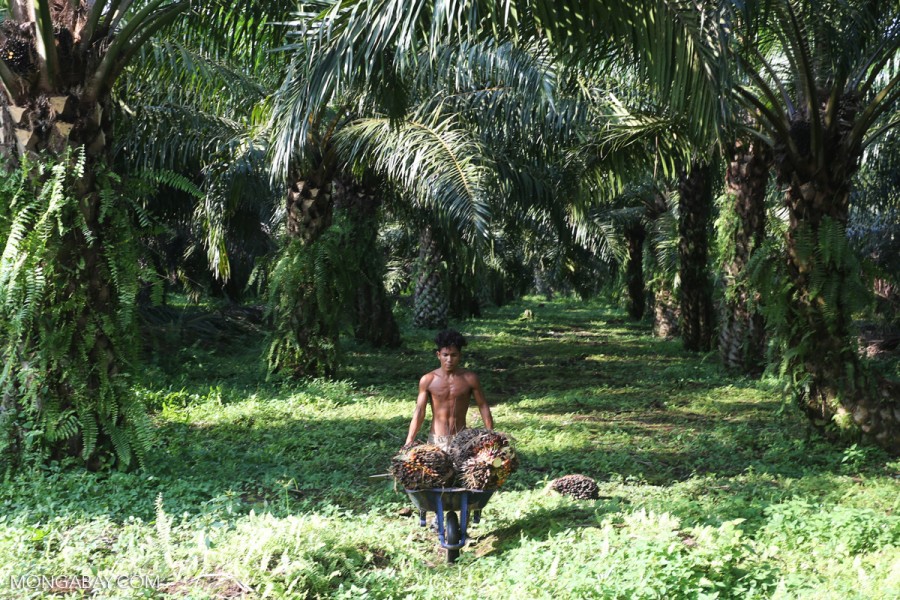- A new study analyzing standards of living over a 14-year period across more than 5,000 villages in Indonesian Borneo finds that oil palm development can have both positive and negative impacts on various aspects of a village’s well-being. The key difference: how intact their forest was to begin with.
- For market-based communities, which have already experienced a higher rate of previous forest degradation, oil palm expansion brought a mixed bag of impacts. These villages saw an increase in “basic” and “financial” well-being over all time scales when compared with similar communities without new plantations, but also suffered more rapid detriment to “environmental” and “social” factors.
- The impacts were much starker for subsistence-based communities, which depend upon the forest for their livelihoods. These villages suffered overall decreases in all well-being categories in the wake of new oil palm development when compared to similar communities without. The proportion of houses without access to electricity and toilets increased with the influx of migrant workers.
The promise of jobs and prosperity often helps palm oil companies convince skeptical local stakeholders to accept development on their lands. However, there has been little objective evidence showing whether a village is better or worse off after allowing a plantation to move in to its backyard — until now.
A new study analyzing standards of living over a 14-year period across more than 5,000 villages in Kalimantan, the Indonesian part of Borneo, finds that oil palm development can have both positive and negative impacts on various aspects of a village’s well-being. The key difference: how intact their forest was to begin with.
Researchers from the University of Queensland and Borneo Futures found that villages that had already transitioned to a market economy — which typically correlates with higher level of previous forest degradation — saw more benefit from plantation development than communities that still relied on subsistence economies.

“Subsistence livelihood villages tend to have large communities with indigenous backgrounds,” lead author Truly Santika told Mongabay, “which means that these communities have stronger ties to ancestral land and livelihoods, and they are also dependent more on forest and environmental income.” Although oil palm plantations may increase employment and economic opportunities in the area, these communities are less adapted to benefit from those changes, and the balance of jobs tends to go to migrants who inevitably follow in the wake of new development, eventually displacing the traditional communities.
“Market-based villages, on the other hand, are generally more culturally diverse, and the communities mostly have livelihood[s] outside the forestry sector, since the forests are generally already lacking,” Santika said. Therefore, the local population is better equipped to adapt to the new jobs and handle the increased circulation of wealth.
Indonesia is the world’s top palm oil producer, accounting for nearly half of global supply.

To assess the changes in well-being of villages over time, the research used data gathered by the Indonesian Bureau of Statistics roughly every three years, known as Potensi Desa (PODES). These surveys assess each village area, or desa, based on multiple criteria in several categories. The “basic” category captures standard living conditions, with villages graded by the number of households with access to electricity, cooking fuels and similar necessities. Infrastructure is captured in the “physical” category, which includes distance to health care and school facilities, while the “financial” category assesses access to financial development schemes and counts the number of small industries. Conflicts among communities and suicide rates are included in the “social” category, and water and air pollution severity is ranked as part of the “environmental” assessment.
After the researchers matched comparable villages based on factors such as topography, accessibility and climate, they were able to directly compare changes in PODES reporting for those villages with no oil palm versus those that had new oil palm developments established from the years 2000 to 2014. Given the frequency of PODES assessments, they were able to quantify the benefits or detriments of oil palm development over the short term (two to three years), medium term (6-8 years) and long term (11-14 years).
As a whole, villages across Kalimantan saw an increase in basic, physical and financial well-being from 2000-2014, regardless of whether plantations became the primary land use nearby or not. At the same time, social and environmental well-being generally decreased across the island.
However, on average, the villages with new oil palm plantations showed slower growth in most well-being factors over all time scales than villages without — the notable exception being an initial short-term spike in infrastructure improvements. Moreover, when these villages are subdivided into subsistence and market-based groups, the nuanced differences in impacts of establishing a plantation becomes more pronounced.
Market-based communities with new oil palm developments saw an increase in basic and financial well-being over all time scales when compared with similar communities without new plantations — but also suffered more rapid detriment to environmental and social factors. The authors suspect the outsized decrease in environmental quality might result from new palm oil processing mills constructed near these communities, which already struggle with water and air pollution.
Subsistence-based communities, however, suffered overall decreases in all well-being categories in the wake of new oil palm development when compared to similar communities without. Large decreases in proportions of houses with access to electricity and toilets drives basic well-being down, while financial well-being suffers as the residents struggle to adapt to a new economy. The authors note, however, that some of these declines may not indicate a reduction in well-being for everyone, but rather reflects an increase in migrant populations which can strain the resources of small previously isolated villages. For example, even if the total number of houses with electricity increases, the PODES indicator, which ranks proportion of houses, may decrease with the influx of new construction.
That being said, however, some indicators such as malnutrition, which continually decreases over time for subsistence-based communities in the wake of new oil palm development, is likely a direct result of these communities losing access to a variety of fruits, vegetables and medicinal plants previously available to them in the forests.

This analysis of new oil palm development effects on Indonesian villages, as quantified by the PODES data, tracks with previously published case studies of the impacts of industrial-scale oil palm on rural villages in developing countries. The authors compiled a literature review of reports from Indonesia, Malaysia, Colombia, Guatemala and Nigeria. While these studies tended to be more localized, they were consistent: the authors write that 92 percent found “a positive association between oil palm plantations and socioeconomic well-being … in villages where the majority of communities rely on market oriented livelihoods … In contrast, an overall negative association was found in villages where the majority of communities rely on subsistence livelihoods (60% of the studies we reviewed indicate a negative association).”
This impact on subsistence-based communities versus market-based is more than just academically interesting as the authors note that almost 60 percent of new oil palm plantations developed in Kalimantan between 2000 and 2014 were established in villages that depended upon the forest for their livelihoods. The authors write that when these previously isolated communities come into abrupt contact with poorly regulated and hastily conceived market economies, this can exacerbate economic disparity, with “a small number of rural and urban elites [taking] the largest share of economic benefits.”
The paper points out that while some of this economic disparity may be alleviated by taxes aimed at redistributing the wealth back into the local economy, only 30 percent of oil palm companies in Sumatra’s Riau province, for example, have met their tax obligations, according to the nation’s anti-corruption agency. This situation is largely a result of poor oversight, as well as a lack of transparency or certainty of land ownership and permits.
In short, the study finds that while jobs and economic prosperity may increase for some in the wake of new oil palm development, the gains are by no means guaranteed or universal. And the potential for negative impacts to villages that rely on intact forest to sustain subsistence-based economies means special care should be taken to consider the short- and long-term effects that oil palm development can have on the well-being of these local communities.
Citation
Santika, T., Wilson, K. A., Budiharta, S., Law, E. A., Poh, T. M., Ancrenaz, M., . . . Meijaard, E. (2019). Does oil palm agriculture help alleviate poverty? A multidimensional counterfactual assessment of oil palm development in Indonesia. World Development, 120, 105-117. doi:10.1016/j.worlddev.2019.04.012
